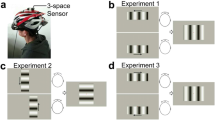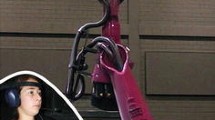Abstract
In the real world, vision operates in harmony with self-motion yielding the observer to unambiguous perception of the three-dimensional (3D) space. In laboratory conditions, because of technical difficulties, researchers studying 3D perception have often preferred to use the substitute of a stationary observer, somehow neglecting aspects of the action-perception cycle. Recent results in visual psychophysics have proved that self-motion and visual processes interact, leading the moving observer to interpret a 3D virtual scene differently from a stationary observer. In this paper we describe a virtual environment (VE) framework which presents very interesting characteristics for designing experiments in visual perception during action. These characteristics arise in a number of ways from the design of a unique motion capture device. First, its accuracy and the minimal latency in position measurement; second, its ease of use and the adaptability to different display interfaces. Such a VE framework enables the experimenter to recreate stimulation conditions characterised by a degree of sensory coherence typical of the real world. Moreover, because of its accuracy and flexibility, the same device can be used as a measurement tool to perform elementary but essential calibration procedures. The VE framework has been used to conduct two studies which compare the perception of 3D variables of the environment in moving and in stationary observers under monocular vision. The first study concerns the perception of absolute distance, i.e. the distance separating an object and the observer. The second study refers to the perception of the orientation of a surface both in the absence and presence of conflicts between static and dynamic visual cues. In the two cases, the VE framework has enabled the design of optimal experimental conditions, permitting light to be shed on the role of action in 3D visual perception.
Similar content being viewed by others
References
Riva G (1998) Virtual environments in neuroscience. IEEE Transactions on Information Technology in Biomedicine 2: 275–281
Pelz JB, Hayhoe MM, Ballard DH, Shrivastava A, Bayliss J, and von der Heyde M (1999) Development of a virtual laboratory for the study of complex human behavior. In: The engineering reality of virtual reality. Proceedings of the SPIE. San Jose, CA 3639B
Findlay JM and Newell FN (1994) Perceptual cues and object recognition. In: Simulated and virtual realities: elements of perception. Carr K and England R eds. London: Taylor & Francis 113–130
Merril JR (1997) Using emerging technologies such as virtual reality and the World Wide Web to contribute to a richer understanding of the brain. Annals of the New York Academy of Sciences 820: 229–233
Ghahramani Z, Wolpert DM (1997) Modular decomposition in visuomotor learning. Nature 386: 392–395
Aguirre GK, Detre JA, Alsop DC, D'Esposito M (1996) The parahippocampus subserves topographical learning in man. Cerebral Cortex 6: 823–829
Bertin RJ, Israel I, Lappe M (2000) Perception of two-dimensional, simulated ego-motion trajectories from optic flow. Vision Research 40 (21): 2951–2971
Viaud D, Ivanenko YP, Berthoz A, Jouvent R (1998) Sex, lies and virtual reality. Nature Neuroscience 1: 15–16
Amorim MA, Trumbore B and Chogyen PL (2000) Cognitive repositioning inside a ‘desktop’ VE: the constraints introduced by first- vs. third-person imagery and mental representation richness. Presence 9: 165–186
Kennedy R, Lane N, Lilienthal M, Berbaum K, Hettinger L (1992) Profile analysis of simulator sickness symptoms: application to virtual environment systems. Presence 1: 295–301
McCauley ME, Sharkey TJ (1992) Cybersickness: perception of self-motion in virtual environment. Presence 1: 311–318
Stanney KM, Hash P (1998) Locus of user-initiated control in virtual environment: influences on cybersickness. Presence 7:447–459
Land MF (1992) Predictable eye-head coordination during driving. Nature 359: 318–320
Grasso R, Glasauer S, Takei Y, Berthoz A (1996) The predictive brain: anticipatory control of head direction for the steering of locomotion. Neuroreport 7: 1170–1174
Koch C, Poggio T (1999) Predicting the visual world: silence is golden. Nature Neuroscience 2: 9–10
Rao RPN, Ballard DH (1999) Predictive coding in the visual cortex: a functional interpretation of some extraclassical receptive-field effects. Nature Neuroscience 2: 79–87
Harris LR, Jenkin M, Zikovitz DC (2000) Vestibular capture of the perceived distance of passive linear self motion. Archives Italiennes de Biologie 138: 63–72
Harris LR, Jenkin M, Zikovitz DC (1998) Vestibular cues and virtual environments. In: Proceedings of VRAIS 1988. Atlanta, GA: IEEE 133–188
Hendrix C, Barfield W (1995) Presence within virtual environments as a function of visual display parameters. Presence 5: 263–273
Yoshikawa T (1990) Foundations of robotics: analysis and control. Cambridge, MA: MIT Press
Panerai F, Hanneton S, Droulez J, Cornilleau-Pérès V (1999) A 6-dof device to measure head movements in active vision experiments: geometric modeling and metric accuracy. Journal of Neuroscience Methods 90: 97–106
Robinett W, Holloway R (1995) The visual display transformation for virtual reality. Presence 4: 1–23
Foley JD, van Dam A, Feiner SK, Hughes JF (1996) Computer graphics: principles and practice. Reading, MA: Addison-Wesley
Panerai F, Comilleau-Pérès V, Droulez J (2002) Contribution of extra-retinal signals to the scaling of object distance during self-motion. Perception & Psychophysics
Peh CH, Panerai F, Droulez J, Cornilleau-Peres V, Cheong LF (2002) Absolute distance perception during in-depth head movement: calibrating optic flow with extra-retinal information. Vision Research (in press)
Wexler M, Panerai F, Lamouret I, Droulez J (2001) Self-motion and the perception of stationary objects. Nature 409: 85–88
Sekuler R, Blake R (1994) Perception. New York: McGraw-Hill
Rogers B, Graham M (1979) Motion parallax as an independent cue for depth perception. Perception 8: 125–134
Lee DN (1980) The optic flow field. Philosophical Transactions of the Royal Society of London (B) 290: 169–179
Koenderink JJ (1986) Optic flow. Vision Research 26: 161–180
Prazdny K (1983) Information in optic flows. Computer Vision, Graphics, and Image Processing 22: 235–259
Goodbody SJ, Wolpert DM (1999) The effects of visuomotor displacement on arm movement parts. Experimental Brain Research 127: 213–223
Flipo A (2000) TRUST: The truck simulator for training. In: Proceedings of Driving Simulation Conference (DSC2000). Paris: INRETS 293–302
Dubrovin A, Levelé J, Prevost A, Lecocq P, Canry M, Kelada JM, Kemeny A (2000) Application of real-time lighting simulation for intelligent front-lighting studies. In: Proceedings of Driving Simulation Conference (DSC2000). Paris: INRETS 333–343.
Nixon MA, McCallum BC, Fright WR, Price NB (1998) The effects of metals and interfering fields on electromagnetic trackers. Presence 7: 204–218
Witmer BG, Singer MJ (1998) Measuring presence in virtual environments: a Presence questionnaire. Presence 7: 225–240
Author information
Authors and Affiliations
Corresponding author
Rights and permissions
About this article
Cite this article
Panerai, F., Ehrette, M. & Leboucher, P. A VE framework to study visual perception and action. Virtual Reality 6, 21–32 (2002). https://doi.org/10.1007/BF01408566
Issue Date:
DOI: https://doi.org/10.1007/BF01408566




